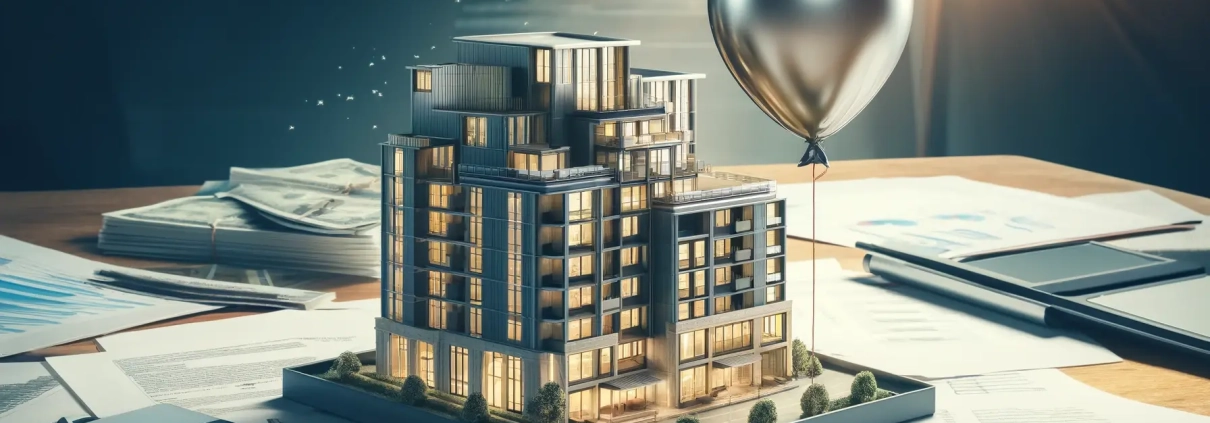Balloon Payment
The final payment on a loan. In commercial real estate, the balloon payment is the entire outstanding balance of the loan as of the loan maturity date. A balloon payment is only due when the loan has not fully amortized.
For instance, a lender extends a mortgage loan of $10,000,000, for a term of five years, with interest-only payments for the entire five years. The balloon payment at loan maturity will be $10,000,000.
In another example, a lender extends a mortgage loan of $10,000,000, for a term of 10 years, with payments amortized over 30 years. While the loan is amortizing, it will not be fully amortized at loan maturity (year 10) and thus the borrower will owe a balloon payment for the balance due.
When underwriting a perspective loan, real estate lenders take special care to analyze the likelihood the borrower will be able to payoff the balloon payment at maturity. They use tools such as refinance analysis risk models to assess whether a payoff of the balloon balance is likely.
Putting ‘Balloon Payment’ in Context
Capital Growth Properties, a renowned real estate investment firm, recently focused its attention on Peachtree Office Park, a suburban office park in Atlanta, Georgia. Peachtree Office Park, comprising 150,000 square feet of rentable space across multiple buildings, presented an ideal core-plus investment opportunity. The property was well-located and functionally sound but required strategic upgrades and a new leasing strategy to realize its full market potential.
Financial Strategy and Balloon Payment Context
The acquisition of Peachtree Office Park was structured with an initial purchase price of $25 million. To finance this acquisition, Capital Growth Properties secured an $18 million mortgage loan at a competitive interest rate. The loan was uniquely structured: it was amortized over 20 years but had a maturity of 7 years, leading to a substantial balloon payment at the end of the term.
The CFO of Capital Growth Properties, Alex Martinez, spearheaded the financial structuring. The loan’s monthly payments were calculated based on a 20-year amortization schedule, which meant more manageable monthly payments but a significant balloon payment of approximately $26,028,450 due at the end of year 7. Alex planned for this balloon payment from the beginning, integrating it into the firm’s long-term financial planning.
Strategic Moves and Risk Mitigation
Capital Growth Properties initiated moderate upgrades to the property, enhancing its appeal and functionality. These improvements were projected to increase the occupancy rate from 80% to 95% within three years and allow for a 10% increase in rental rates over the same period. The projected net operating income (NOI) was expected to grow from $1.5 million to $2.1 million annually.
Understanding the risks associated with a balloon payment, Alex and his team also closely monitored market conditions and maintained a strong relationship with their lenders. Their exit strategy included the possibility of refinancing the loan if interest rates remained favorable or selling the property at a higher value due to the improvements and increased NOI.
Financial Outcomes and Balloon Payment Strategy
By year 7, the strategic upgrades and active management had significantly increased the property’s value to an estimated $35 million. This positioned Capital Growth Properties favorably to address the balloon payment either through refinancing, supported by the higher property value and improved cash flow, or through a sale at a substantial gain.
This case exemplifies how careful planning and strategic financial management are crucial when dealing with substantial balloon payments in commercial real estate investments. Alex’s foresight in planning for the balloon payment ensured that it did not become a financial burden, instead integrating it as a manageable aspect of their broader investment strategy.
Frequently Asked Questions about Balloon Payments in Commercial Real Estate
What is a balloon payment?
A balloon payment is the final lump-sum payment due at the end of a loan term when the loan has not fully amortized. It represents the remaining unpaid principal balance.
When does a balloon payment occur in commercial real estate?
Balloon payments occur when a loan term is shorter than its amortization period. For example, a 10-year loan amortized over 30 years will result in a balloon payment at the end of year 10.
Can you provide an example of a balloon payment structure?
Yes. Capital Growth Properties secured an $18 million loan amortized over 20 years with a 7-year maturity. At maturity, they faced a balloon payment of approximately $26,028,450.
How do lenders assess balloon payment risk?
Lenders use refinance risk models to evaluate the borrower’s likelihood of repaying or refinancing the balloon payment, considering factors like projected property value, NOI, and interest rates at maturity.
What are strategies to address a balloon payment at maturity?
Common strategies include refinancing the loan using improved property value and NOI, or selling the asset before or at loan maturity to pay off the remaining balance.
What are the risks associated with balloon payments?
The main risks include the inability to refinance due to adverse market conditions or a decline in property value, which can lead to default or forced sale at unfavorable terms.
Why would a borrower agree to a balloon payment loan structure?
Balloon loans often have lower monthly payments during the loan term, allowing borrowers to manage short-term cash flow while planning for future refinancing or asset disposition.
Click here to get this CRE Glossary in an eBook (PDF) format.

